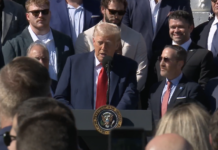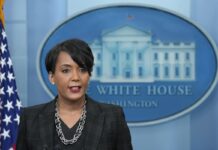
For some, the federal proposal to bump a rare Southern bird from the endangered species list represents a great success story in conservation.
But to others, the move puts at risk the red-cockaded woodpecker’s fragile gains made in the 50 years since the species was deemed to be nearing extinction. For decades, the bird has been protected under the same federal wildlife law credited with saving the bald eagle, the American alligator, and other species.
Under the proposal, the woodpecker would instead be deemed a threatened species and, through a complicated rule, the species would have protections that the forestry industry argues are even tougher than today’s regulations.
The U.S. Fish and Wildlife Service proposed the change this fall with fanfare from military leaders and federal officials, including U.S. Secretary of Agriculture Sonny Perdue, at an announcement made at Georgia’s Fort Benning.
Under the Trump administration, the federal agency touts the number of species that have been removed from the list of endangered species or downlisted to threatened in just a few short years. That has drawn criticism from environmentalists and praise from those who see the Endangered Species Act’s protections as government overreach.
But a just-ended public input period turned up concerns from conservationists and birding enthusiasts who say red-cockaded woodpecker sightings are still so rare that they must travel to certain areas – and even look for certain trees – just to catch a glimpse of one.
“What is so concerning to us, and what is so upsetting, is that this species could and should be an ESA success story,” said Ramona McGee, a staff attorney with the Southern Environmental Law Center.
“The species has made significant strides as a result of intense management and federal oversight, but the service is about to prematurely pull the rug out from under the species and undo those 50 years of conservation efforts by removing key protections and key incentives for managing red-cockaded woodpeckers,” McGee said.
The law center submitted a lengthy statement opposing the changes on behalf of two dozen conservation groups, including Georgia Audubon and national organizations like Defenders of Wildlife and the Center for Biological Diversity.
The conservation groups argue that the proposal to reclassify the now-endangered species to threatened is unsupported by science, allows the birds to be harmed on military bases – where the woodpecker is thriving – and they criticize the proposal as being out of step with standards for changing a species’ status.
They also say the plan will leave the species vulnerable as threats like climate change intensify, with stronger tree-ravaging hurricanes further jeopardizing the bird’s habitat.
“The reality is that we are going to continue having more and bigger and worse storms, and that’s going to lead to more of these isolated populations being impacted,” McGee said. “Some that may very likely be completely killed off by single storm events or by repeatedly been hit by storm events, and that poses a real risk of extinction for the entire species.”
‘A conservation-reliant species’
Once common throughout the Southeast, the red-cockaded woodpecker population dwindled after European settlement brought severe habitat loss for a bird that prefers mature longleaf pine trees.
Commercial timber harvesting, the turpentine industry, urbanization, and agriculture have contributed to the near disappearance of the bird’s favored centuries-old trees, though there are ongoing efforts to restore longleaf pine forests.
Red-cockaded woodpeckers are small in stature and earned their name for the small red flourish on an adult male’s cheek that is only visible when he’s excited. The birds are known for the cavities they spend years carving out in living pine trees, which later become habitat for a host of other animals. Building move-in-ready artificial cavities has been a key conservation strategy for the bird.
“Cavity excavation is actually extremely difficult, making a cluster of cavity trees a very valuable resource with the species,” Kristi Young, deputy manager of conservation and classification with the U.S. Fish and Wildlife Service, said at a public hearing held this month.
The species is still small in numbers in many of the pockets of red-cockaded woodpeckers across the South, but most of them are stable or showing signs of growth, according to Young.
“We determine that the species is no longer in danger of extinction,” Young said. “However, the red-cockaded woodpecker still faces a variety of threats, and the species continues to be reliant on conservation management.
“Therefore, we determined that the species is likely to become an endangered species within the foreseeable future. This is the definition of a threatened species,” she said.
Young said the red-cockaded woodpecker is “a conservation-reliant species,” meaning its fate depends on the continued management of populations and habitat. Some of the still-looming risks for the woodpecker’s survival include lack of suitable habitat, natural disasters like hurricanes and the existence of small, fragmented populations.
McGee said in an interview that the woodpecker is likely another decade or so away from being ready to lose its endangered status based on the federal agency’s earlier projections.
Pushback from industry
The potential downlisting of the bird is broadly hailed as a conservation success by tree farmers and forestry business interests.
The industry, though, has also pushed back on regulations they argue are tougher than what is currently in place. For example, forestry producers say a half-mile ban on herbicide use where woodpeckers exist is more stringent than today’s rules for spraying near the bird’s habitat.
The Georgia Forestry Association signed onto a letter from a coalition of state forestry associations that praised the downlisting while lodging their objections, saying the proposal does not offer “a meaningful reduction in the regulatory framework” surrounding the bird.
Andres Villegas, president and CEO of the Georgia Forestry Association, makes the case that herbicides can actually help the red-cockaded woodpecker because it kills off invasive plants or wild growing understory that can make it harder for the bird to reach the ground to forage.
Villegas says the appearance of the rare bird on a tree producer’s property was once a dreadful sight, but that there is a growing desire among landowners who want to do more for wildlife on their property.
“I think the landowner ethos is there to help recover and conserve species, but what isn’t necessarily there is a big appetite for highly restrictive regulations that sometimes may not be the right recipe for success in a region or for a particular landowner, or even sometimes for a particular species,” Villegas said.
Villegas said he remained hopeful that the federal regulators will rethink the details of the proposal – and that the proposal will survive the transition to a new president. President-elect Joe Biden will be sworn in on Jan. 20.
The federal agency has until next fall to act, so it is possible the question of the woodpecker’s status – and other proposed changes to the bedrock conservation law – will fall to the Biden administration.
This article appears in partnership with Georgia Recorder







